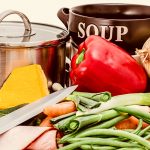In an era where what we eat has become more like a list of do’s and don’ts than a natural choice, it can be hard to decide what to include in our diet.
 Our ability to eat out of instinct has been disrupted by facts and trends. In addition, we have become a melting pot of cultures and now have more options than ever before to choose between. So what can be done to reduce confusion and make choices that are truly good for us? One way is to narrow our focus down to the basics with something like bone broth.
Our ability to eat out of instinct has been disrupted by facts and trends. In addition, we have become a melting pot of cultures and now have more options than ever before to choose between. So what can be done to reduce confusion and make choices that are truly good for us? One way is to narrow our focus down to the basics with something like bone broth.
In many societies, bone broth is a daily staple. It is an inexpensive, highly nutrient-dense food and an excellent source of minerals. It is high in calcium, magnesium, and phosphorus which make it an excellent choice for supporting bone and tooth health. Bone broth is also very high in amino acids and collagen both of which are important for healthy connective tissue that supports joints, hair, skin, and nails. It can also aid digestion and boost the immune system, which is why we think of soup when we are sick. For such a simple thing it can be truly transformative for our health.
Making bone broth is a rather simple process, but it does take time. I advise you make it in bulk and freeze some for a later date. Another great trick is to save bones from roasted chickens and scraps from veggies in the freezer to add to the pot when you do make a batch of bone broth.
Here is what you will need:
These 2 recipes are taken from the cookbook Nourishing Traditions by Sally Fallon
Beef Stock
- About 4 pounds beef marrow and knuckle bones
- 1 calves foot, cut into pieces (optional)
- 3 pounds meaty rib or neck bones
- 4 or more quarts cold filtered water
- 1/2 cup vinegar
- 3 onions, coarsely chopped
- 3 carrots, coarsely chopped
- 3 celery stalks, coarsely chopped
- several sprigs of fresh thyme tied together
- 1 teaspoon dried green peppercorns, crushed
- l bunch parsley
1. Place the knuckle and marrow bones and optional calves foot in a very large pot with vinegar and cover with water. Let stand for one hour. Meanwhile, place the meaty bones in a roasting pan and brown at 350 degrees in the oven. When well browned, add to the pot along with the vegetables. Pour the fat out of the roasting pan, add cold water to the pan, set over a high flame and bring to a boil, stirring with a wooden spoon to loosen up coagulated juices. Add this liquid to the pot. Add additional water, if necessary, to cover the bones; but the liquid should come no higher than within one inch of the rim of the pot, as the volume expands slightly during cooking. Bring to a boil. A large amount of scum will come to the top, and it is important to remove this with a spoon. After you have skimmed, reduce heat and add the thyme and crushed peppercorns.
2. Simmer stock for at least 12 and as long as 72 hours. Just before finishing, add the parsley and simmer another 10 minutes. You will now have a pot of rather repulsive-looking brown liquid containing globs of gelatinous and fatty material. It doesn’t even smell particularly good. But don’t despair. After straining you will have a delicious and nourishing clear broth that forms the basis for many other recipes in this book.
3. Remove bones with tongs or a slotted spoon. Strain the stock into a large bowl. Let cool in the refrigerator and remove the congealed fat that rises to the top. Transfer to smaller containers and to the freezer for long-term storage.
Chicken Stock
- 1 whole free-range chicken or 2 to 3 pounds of bony chicken parts, such as necks, backs, breastbones, and wings*
- gizzards from one chicken (optional)
- 2-4 chicken feet (optional)
- 4 quarts cold filtered water
- 2 tablespoons vinegar
- 1 large onion, coarsely chopped
- 2 carrots, peeled and coarsely chopped
- 3 celery stalks, coarsely chopped
- 1 bunch parsley
*Note: Farm-raised, free-range chickens give the best results. Many battery-raised chickens will not produce stock that gels.
1. If you are using a whole chicken, cut off the wings and remove the neck, fat glands and the gizzards from the cavity. Cut chicken parts into several pieces. (If you are using a whole chicken, remove the neck and wings and cut them into several pieces.) Place chicken or chicken pieces in a large stainless steel pot with water, vinegar and all vegetables except parsley. Let stand 30 minutes to 1 hour. Bring to a boil, and remove scum that rises to the top. Reduce heat, cover and simmer for 6 to 8 hours. The longer you cook the stock, the richer and more flavorful it will be. About 10 minutes before finishing the stock, add parsley. This will impart additional mineral ions to the broth.
2. Remove whole chicken or pieces with a slotted spoon. If you are using a whole chicken, let cool and remove chicken meat from the carcass. Reserve for other uses, such as chicken salads, enchiladas, sandwiches or curries. Strain the stock into a large bowl and reserve in your refrigerator until the fat rises to the top and congeals. Skim off this fat and reserve the stock in covered containers in your refrigerator or freezer.
Often times I will not cook my broth for the full 12 hours and instead will do a quick broth as a base for many of my soups. You can follow the instructions above, but shorten the cooking time by about 2 hours. If you are interested in learning more about the kinds of broths you can make Nourishing Traditions Cookbook is a wonderful reference guide to fish stocks, shrimp stocks and includes tons of information on their health benefits. Store-bought bone broth is always an option if you are in last minute pinch, but making your own broth at home will most certainly bring an unmatched wholesomeness to your table.
Here’s to your health and exploring foods that nourish!
For another look at the many bone broth benefits check this out! https://www.cognitune.com/bone-broth-benefits/
